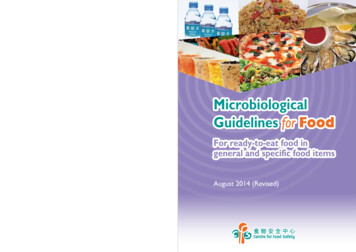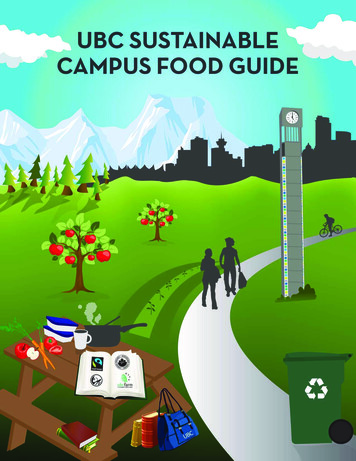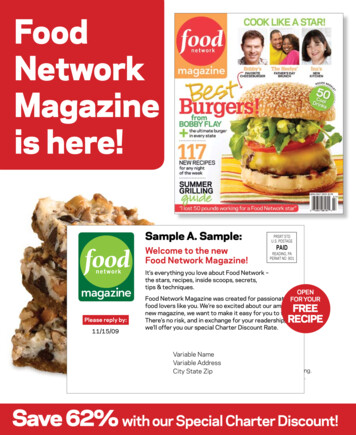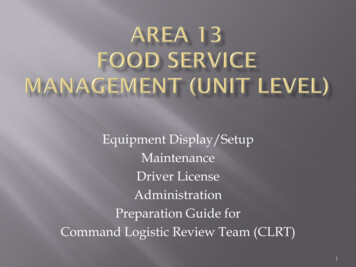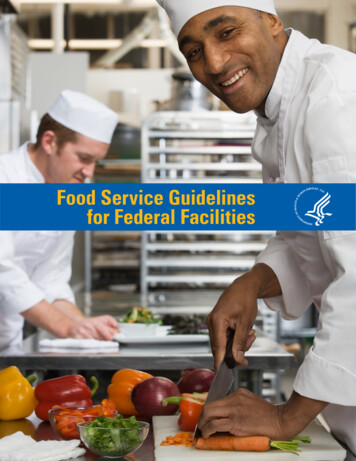
Transcription
Food Service Guidelinesfor Federal Facilities
ContributorsContributors to the authorship of the Food Service Guidelinesfor Federal Facilities were from the Food Service GuidelinesFederal Workgroup. This workgroup consisted of more than60 representatives from the following nine federaldepartments and agencies:U.S. Department of Health and Human Serviceszz U.S. General Services Administrationzz U.S. Department of Agriculturezz U.S. Department of Commercezz U.S. Department of Defensezz U.S. Department of Educationzz U.S. Environmental Protection Agencyzz U.S. Department of Interiorzz U.S. Department of Veterans AffairszzSuggested Citation:Food Service Guidelines Federal Workgroup. Food Service Guidelinesfor Federal Facilities. Washington, DC: U.S. Department of Health andHuman Services; 2017.
ContentsIntroduction . . . . . . . . . . . . . . . . . . . . 5Purpose, Goals, and Audience for theFood Service Guidelines for Federal Facilities. . 6Standards for the Food Service Guidelinesfor Federal Facilities . . 9Food and Nutrition Standards. . 10Facility Efficiency, Environmental Support, and CommunityDevelopment Standards. 14Food Safety Standards. . 18Behavioral Design. . . . . . . . . . . . 20Glossary. . . . . . . . . . . . . . . . . . . . . . . . . . . . . . . . . . 23References. . . . . . . . . . . . . . . . . . . . . . . . . . . 273
— PAGE INTENTIONALLY LEFT BLANK —
Introduction5
The U.S. Department of Health and Human Services (HHS) and the U.S. General ServicesAdministration (GSA) collaboratively released the first food service guidelines for federalfacilities in March 2011 in an effort to assist employees in making healthier food and beveragechoices and to create an efficient and environmentally beneficial food service system.1 Thoseguidelines, Health and Sustainability Guidelines for Federal Concessions and Vending Operations,1(referred to here as the 2011 HHS / GSA Guidelines) have been updated and renamed, FoodService Guidelines for Federal Facilities.Updates to the Food Service Guidelines for Federal Facilities primarily include the following: 1)alignment of food and nutrition standards with the 2015 – 2020 Dietary Guidelines for Americans,8th Edition2 (referred to here as the 2015 – 2020 Dietary Guidelines); 2) alignment with ExecutiveOrder 13693 (Planning for Federal Sustainability in the Next Decade)3 on energy efficiency andenvironmental performance; 3) additions of food safety standards aligned with the FoodCode4 to ensure protection against foodborne illnesses; and 4) behavioral design strategies forencouraging selection of healthier foods and beverages.Goals of the Food Service Guidelines for Federal FacilitiesThe standards in the Food Service Guidelines for Federal Facilities are designed to achievethree primary goals. These goals are to ensure that:zz Healthier foods and beverages are availableand encouraged at federal facilities.zz Environmentally responsible practices are conducted in federal food servicevenues, and communities are economically supported through local food sourcing.zz Food safety practices are followedto minimize the risk of foodborne illnesses.Purpose, Goals, and Audience for the Food ServiceGuidelines for Federal FacilitiesThe purpose of the Food Service Guidelines for Federal Facilities is to provide specific standardsfor food, nutrition, facility efficiency, environmental support, community development, foodsafety, and behavioral design for use in food service concession and vending operations atfederal facilities; examples include cafeterias, cafés, snack bars, grills, concession stands, sundryshops, micro markets,*1and vending machines. The Food Service Guidelines for Federal Facilitiesis to be used primarily for developing contracts and permits for the delivery of food service inthese settings.The intended audiences for this document are federal acquisition officials and staff whodevelop requests for food service proposals and negotiate contracts; food service vendorscompeting for federal food service contracts; participants in the Randolph-Sheppard Vending* See glossary for definition.6
Facility Program;†2and persons who monitor or advise food service operations, such as worksitewellness stakeholders or contracting officers. The guidelines in this document may also serveas a model for concession and vending operations at state, local, and tribal government andprivate worksite facilities.Two types of food service are provided in federal facilities. One type includes food servicevenues in which food is sold (such as cafeterias, cafés, and vending machines) and customerspurchase their food and beverages from a variety of choices. The other type includes venues inwhich food is served (such as federal hospitals, correction facilities, or military dining facilities),and the government is responsible for providing individuals with meals that meet all or part oftheir daily or weekly nutrition needs and individual choice may be limited.‡3With the exceptionof the food safety standards, which apply in both types of venues, the standards in the FoodService Guidelines for Federal Facilities are written specifically for federal food service venueswhere food is sold (although they can be adapted to venues where food is served).Process for Updating the Food Service Guidelines for Federal FacilitiesThe standards included in this update were determined by the Food Service Guidelines FederalWorkgroup, which consisted of more than 60 representatives from nine federal departmentsand agencies. The workgroup formed three subcommittees (Food and Nutrition, FacilityEfficiency and Procurement, and Food Safety) and a subgroup (Behavioral Design WorkingGroup) to determine the standards for inclusion in the Food Service Guidelines for FederalFacilities. Details of the complete process for updating the Food Service Guidelines for FederalFacilities and the rationales for decisions regarding the standards are found in An AncillaryReport of the Food Service Guidelines for Federal Facilities.5† The Randolph-Sheppard Vending Facility Program “provides persons who are blind with remunerative employment and self-supportthrough the operation of vending facilities on federal and other property.” See https://www2.ed.gov/programs/rsarsp/index.html for moreinformation.‡ The Food Service Guidelines for Federal Facilities does not apply to food served to children in child care or school settings that are governed byfederal laws and regulations, including the National School Lunch Program, the School Breakfast Program, the Child and Adult Care Food Program, and the Summer Food Service Program.7
— PAGE INTENTIONALLY LEFT BLANK —8
Standards for the Food Service Guidelinesfor Federal Facilities
Best Business PracticesThe Food Service Guidelines for Federal Facilities represents a set of voluntary bestbusiness practices that can be implemented at federal departments and agenciesto increase healthy and safe food options for employees, while also improving facilityefficiency and supporting the community through sourcing and procurement of local andregional foods.The standards in the Food Service Guidelines for Federal Facilities are categorized into foursections. These are Food and Nutrition; Facility Efficiency, Environmental Support, andCommunity Development; Food Safety; and Behavioral Design.The Food Service Guidelines for Federal Facilities identifies two levels of implementation:Standard and Innovative. The criteria for both implementation levels are supported by thescientific literature to be beneficial to health and / or the environment, or align with existingnational policy or guidance. These terms are defined as follows:criteria are considered to be widely achievable within food service.Implementation at the standard level is expected.zz Standardcriteria promote exceptional performance in various areas of food service.Implementation at the innovative level is encouraged.zz InnovativeFood and Nutrition StandardsThe United States government encourages the availability, promotion, and consumptionof healthier foods and beverages as a way to support optimal health and prevent nutritionrelated chronic diseases,2 several of which are among the leading causes of death.6 The2015 – 2020 Dietary Guidelines, published by HHS and the U.S. Department of Agriculture(USDA), outlines healthy diets for people aged 2 years and older and states that “all segmentsof society — individuals, families, communities, businesses and industries, organizations,government, and others — can and should align with the Dietary Guidelines.”2 The 2015 – 2020Dietary Guidelines serves as the basis for the Food and Nutrition standards included in the FoodService Guidelines for Federal Facilities.In the 2011 HHS / GSA Guidelines, the food and nutrition standards were categorized asConcessions and Vending. In the updated Food Service Guidelines for Federal Facilities, thestandards are classified as Prepared Foods, Packaged Snacks, and Beverages (Tables 1, 2 and3) to simplify guidance for the vendor, and to ensure that standards for similar products applyacross all types of food service venues. Using this categorization of standards, the criteria canapply across all concession and vending operations, except as noted. The categories are definedas follows:10
zz Prepared Foods. Thiscategory includes foods that are fresh, cleaned, cooked, assembled(e.g., salad or sandwich), or otherwise processed and served “ready-to-eat.” Prepared foodsinclude those that are made and served on site, or those prepared at a central kitchen andthen packaged and distributed to other locations. These foods have a relatively limitedshelf-life (compared to packaged snacks), and can be sold in any food service venue.Examples of prepared foods include hot entrées, side dishes, soups, salads, deli sandwiches,and fresh whole fruits and vegetables.zz Packaged Snacks. Thiscategory includes processed foods that are packaged in smallportions or individual servings, are widely distributed, and have a relatively long shelf-life(compared to prepared foods). Packaged snacks include food items such as granola bars,chips, crackers, raisins, and nuts and seeds. These foods can be sold in any venue, such asvending machines or “grab-n-go” areas of cafeterias.zz Beverages. Thiscategory includes drinks such as water, milk, 100% juice, soft drinks,energy drinks, teas, and coffees.Table 1. FOOD AND NUTRITION Standards for Prepared Foods, Food Service Guidelinesfor Federal FacilitiesCategoryFruits mentationLevelaOffer a varietyb of at least 3 fruitc options daily, with no added sugars. Fruitcan be fresh, canned,d frozen, or dried.eStandardOffer a varietyb of at least 3 non-fried vegetable options daily. Vegetablescan be fresh, frozen, or canned, and served cooked or raw.StandardOffer seasonal fruit and vegetables.StandardOffer half of total grains as “whole grain-rich” products,b daily.StandardOffer a “whole grain-rich” productb as the first (i.e., defaultb) choice.InnovativeOffer a variety of low-fat dairy productsb (or dairy alternatives) daily, such asmilk, yogurt, cheese, and fortified soy beverages.StandardWhen yogurt is available, offer at least one low-fat plain yogurt.InnovativeOffer a varietyb of non-fried protein foods, such as seafood,b lean meats andpoultry,b eggs, legumes (beans and peas), nuts, seeds, and soy products,daily.StandardOffer protein foods from plants, such as legumes (beans and peas), nuts,seeds, and soy products, at least three times per week.StandardOffer protein foods from plants such as legumes (beans and peas), nuts,seeds, and soy products, daily.InnovativeOffer seafoodb at least two times a week.StandardContinued11
StandardsDessertsWhen desserts are available, offer 25% of desserts containing 200 caloriesas served.StandardAll mealsb offered contain 800 mg sodium.StandardAll entreesb offered contain 600 mg sodium.StandardAll side itemsb contain 230 mg sodium.StandardTrans FatsAll foods do not include partially hydrogenated oils.StandardCalorie andNutritionLabelingProvide calorie and nutrition information of standard menu items asrequired by the Food and Drug Administration (FDA) in Menu Labeling FinalRule: Food Labeling; Nutrition Labeling of Standard Menu Items in Restaurantsand Similar Retail Food Establishments.fStandardSodiumOtherLimit deep-fried entrée options to no more than one choice per ndardStandard implementation criteria are considered to be widely achievable within food service; implementation at this level is expected. Innovativeimplementation criteria promote exceptional performance in various areas of food service; implementation at this level is encouraged.b See glossary for definition.c Fruits mixed with foods from other food groups such as grain and dairy do not count towards meeting this standard.d Canned fruit may be packed in 100% juice with no added sugars.e Dried fruits are exempted from the sugar criterion for this standard. Dried fruits may contain nutritive sweeteners required for processing and / or palatability.f The rule “applies to restaurants and similar retail food establishments if they are part of a chain of 20 or more locations, doing business under the same name,offering for sale substantially the same menu items and offering for sale restaurant-type foods.”7 Restaurants or similar retail food establishments (includingfood service operations) with fewer than 20 locations may voluntarily register to be covered by the rule.712
Table 2. FOOD AND NUTRITION Standards for Packageda Snacks, Food Service Guidelinesfor Federal FacilitiesCategoryStandardsImplementationLevelbAll packaged snacks contain 200 mg sodium per package.StandardAll packaged snacks have 0 grams of trans fat.StandardAt least 75% of packaged snacks meet the following food and nutrient standards.Food Standards:zzHave as the first ingredient a fruit, a vegetable, a dairy product, or a protein food; orzzBe a whole grain-rich grain product;d orzzBe a combination food that contains at least ¼ cup of fruit and / or vegetable.Food andNutrient ANDNutrient Standards:ProfileczzCalorie limit: 200 caloriesStandardzzSaturated fat limit: 10% of calories Exemptions: Reduced-fat cheese and part skim mozzarella; nuts, seeds and nut / seedbutters; and dried fruit with nuts / seeds with no added nutritive sweeteners or fats.zzSugar limit: 35% of weight from total sugars in foods. Exemptions: Dried / dehydrated whole fruits or vegetables with no added nutritivesweeteners; dried whole fruits or pieces with nutritive sweeteners required forprocessing and / or palatability; products consisting of only exempt dried fruit withnuts and / or seeds with no added nutritive sweeteners or fats.CalorieLabelingAll snack foodse sold in vending machines are consistent with FDA’s VendingMachine Final Rule: Food Labeling; Calorie Labeling of Articles of Food in VendingMachines.fStandardaStandards are written to apply per package, irrespective of size or number of servings.Standard implementation criteria are considered to be widely achievable within food service; implementation at this level is expected. Innovativeimplementation criteria promote exceptional performance in various areas of food service; implementation at this level is encouraged.c The food and nutrient profile standards were adapted from USDA’s Smart Snacks in School nutritional criteria. 8d See glossary for definition.e This standard applies to both packaged and unpackaged snack foods sold in vending machines.f This rule “requires operators who own or operate 20 or more vending machines to disclose calorie information for food sold from vending machines, subjectto certain exemptions.”9 Vending machine operators with fewer than 20 vending machines may voluntarily register to be covered by the rule.9b13
Table 3. FOOD AND NUTRITION Standards for Beverages, Food Service Guidelinesfor Federal LevelaProvide free access to chilled, potable water.StandardWhen milk and fortified soy beverages are available, offer low-fat beverages withno added sugars.StandardWhen juice is available, offer 100% juice with no added sugars.bStandardAt least 50% of available beverage choices contain 40 calories per 8 fluidouncesc (excluding 100% juice and unsweetened fat-free or low-fat [1%] milk).StandardAt least 75% of available beverage choices contain 40 calories per 8 fluidouncesc (excluding 100% juice and unsweetened fat-free or low-fat [1%] milk).InnovativeaStandard implementation criteria are considered to be widely achievable within food service; implementation at this level is expected. Innovativeimplementation criteria promote exceptional performance in various areas of food service; implementation at this level is encouraged.b Vegetable juice contains 230 mg sodium per serving.c Equivalent measures include 60 calories per 12 fluid ounces or 100 calories per 20 fluid ounces.Facility Efficiency, Environmental Support, and CommunityDevelopment StandardsThe United States government encourages practices that are beneficial to the environment,largely through the efforts of federal departments and agencies, such as USDA and the U.S.Environmental Protection Agency (EPA). All federal departments and agencies have beencharged (through executive orders) to follow environmentally sound operating proceduresin the management of their buildings. Food service, as part of overall building operations,is a key area in which strategies and policies canbe implemented to reduce environmental impact,increase energy efficiency, and improve facilitymanagement of natural resources.Executive Order 13693,3 which was released in March2015, directs government agencies to increase energyefficiency and improve environmental performance.Among the many goals set forth in Executive Order13693, was a goal for 50% diversion of non-hazardoussolid waste, including food and compostablematerial.3 Additionally, in September 2015, USDA andEPA announced the “first-ever national food wastereduction goal, calling for a 50-percent reduction by2030.”10 Many of the standards in this section of the14
Food Service Guidelines for Federal Facilities were updated from the 2011 HHS / GSA Guidelines toalign with Executive Order 13693.3 Other standards were updated to align with EPA11 – 15 andUSDA guidance.16Standards from the 2011 HHS / GSA Guidelines were reorganized into the current classificationsof Purchasing, Food Service Management and Consumer Engagement, and Waste Diversion.Unlike other sections in the Food Service Guidelines for Federal Facilities, in which standardsapply across food service venues, the standards in the Facility Efficiency, EnvironmentalSupport, and Community Development section apply to concessions (such as cafeterias,snack bars, and grills) unless noted as applying to vending. See Table 4 for the completelist of standards.Table 4. FACILITY EFFICIENCY, ENVIRONMENTAL SUPPORT, and COMMUNITY DEVELOPMENTStandards for the Food Service Guidelines for Federal nLevelaInstitute accurate forecastingb and just-in-time ordering concepts.cStandardProvide materials for single-service items (e.g., bottled beverage containers,trays, flatware, plates, bowls) that are compostable and / or made frombiobasedb,d products.StandardUse bulk-serve condiments instead of single-serve packs, while followingnecessary food safety procedures.eStandardWhen purchasing packaged products, give preference to products inrecyclable, compostable, or biobasedb,d packaging.StandardUse cleaning products and services that are environmentally preferable,b,fwhile following necessary food safety procedures.StandardOffer at least 25% of foods and beverages as locally sourced,b,g certifiedorganic,b,h produced with another certified community-development orenvironmentally beneficial practice, or any combination thereof.iStandardOffer at least 35% of foods and beverages as locally sourced,b,g certifiedorganic,b,h produced with another certified community-development orenvironmentally beneficial practice, or any combination thereof.iInnovativeFOR VENDING: Offer at least 10% of foods and beverages as locallysourced,b,g certified organic,b,h produced with another certifiedcommunity-development or environmentally beneficial practice, or anycombination thereof.iInnovativeWhen seafood options are available, offer seafood procured from fisheriesand aquaculture operations that are responsibly managed, sustainable, andhealthy. Purchasing U.S. wild-captured and farmed seafood, which adhereto some of the most strict sustainability practices in the world, is one wayto ensure compliance with this standard.jStandardContinued15
CategoryFood ServiceManagementand mote and incentivize the use of reusable beverage containers, whilefollowing necessary food safety procedures.kStandardUse or promote the use of reusable serving ware such as plates, utensils,bags, and other service items, while following necessary food safetyprocedures.kInnovativeUtilize cleaning practices and equipment operations that conserveresources, such as water and energy. These could include using ENERGYSTARl and WaterSense products and services.mStandardUse integrated pest management practices, green pest control alternatives,and a routine cleaning schedule, while following necessary food safetyprocedures.nStandardWhen applicable, label food products at the point of purchase as locallysourced,b,g certified organic,b,h or produced with another certifiedcommunity-development or environmentally beneficial practice.StandardProvide information to customers on food products that are locallysourced,b,g certified organic,b,h or produced with another certifiedcommunity-development or environmentally beneficial practice.InnovativeFOR VENDING: Provide information to customers on food products that arelocally sourced,b,g certified organic,b,h or produced with another certifiedcommunity-development or environmentally beneficial practice.InnovativePartner with a farmers’ market that operates on-site.oInnovativeFOR VENDING: If purchasing new vending machines, purchase ENERGYSTAR certified machines or those that meet ENERGY STAR criteria.pStandardFOR VENDING: Retrofit existing vending machines (refrigerated and nonrefrigerated) to use energy conservation methods such as LED lighting,occupancy sensors, or shut down or set-back modes.InnovativeContinued16
aParticipate in and implement waste diversion programs (waste reduction,recycling, and where feasible, composting) for employees in the kitchen,break rooms, and administrative areas (i.e., back-of-house operations).StandardParticipate in and implement waste diversion programs (waste reduction,recycling, and where feasible, composting) in areas that a consumer willbe exposed to during their visit to the food service operation (i.e., front-ofhouse operations).StandardImplement systems to monitor relationship between waste and foodprocurement, including the development of goals for waste reductionand quarterly to annual reporting of waste reduction and waste diversionbenchmarks.qStandardRe-purpose excess food for future meal preparation, while followingnecessary food safety procedures.rStandardTrain staff on methods for reducing food waste.StandardDonate edible surplus food for human consumption where possible, whilefollowing necessary food safety procedures.sInnovativeaStandard implementation criteria are considered to be widely achievable within food service; implementation at this level is expected. Innovativeimplementation criteria promote exceptional performance in various areas of food service; implementation at this level is encouraged.b See glossary for definition.c For information on forecasting, just-in-time ordering, and other food waste reduction strategies see EPA’s Reducing Wasted Food & Packaging: A Guide for FoodServices and Restaurants at documents/reducing wasted food pkg tool.pdf.d See USDA’s BioPreferred Program website: ges/AboutBioPreferred.xhtml. USDA’s BioPreferred Programlists products that are both biobased and compostable.e See the FDA Food Code for considerations when using bulk serve condiments, Sections: 3-306.11, 3-306.12, 3-306.13, 3-306.14, and 3-307.11.f For information on environmentally preferable products and services, see EPA’s “About the Environmentally Preferable Purchasing Program” website t-environmentally-preferable-purchasing-program; EPA’s “Sustainable Marketplace: Greener Products andServices” website at https://www.epa.gov/greenerproducts; EPA’s “Safer Choice Products” website at hoice-label; and GSA’s “Sustainable Facilities Tool” website at https://sftool.gov/. For guidance on safe cleaning practices, see the FDA Food Code, Chapters andSubparts: 4-5, 4-6, and 4-7.g Based on the definition provided in the Food, Conservation, and Energy Act of 2008: Conference Report to Accompany H.R. 2419, locally sourced refers to anagricultural product that is transported less than 400 miles from its origin or is distributed within the same state as it was produced.17h For information on organic production see USDA’s “Organic Agriculture” website at d organicagriculture and USDA’s “National Organic Program” website at /national-organic-program.i Although locally sourced, certified organic, and produced with another certified community-development or environmentally beneficial practice may not bemutually exclusive, the intent of this standard is to ensure that the noted percentage (10%, 25%, or 35%) of the product line is met by any combination of thesecriteria.j The National Oceanic and Atmospheric Administration (NOAA) FishWatch Program defines sustainable seafood as “catching or farming seafood responsibly,with consideration for the long-term health of the environment and the livelihoods of the people that depend upon the environment.” Verifying the healthand sustainability of U.S. and international fisheries is not always simple. Domestic fisheries and aquaculture are managed and regulated by federal and stateagencies under legally established fisheries management plans and a host of environmental and food safety laws. Seafood caught or farmed in U.S. waters orin the United States has been produced responsibly / sustainably. International fisheries are managed under sovereign laws and international treaties. Guidanceon how to make sustainable seafood choices is found on the NOAA FishWatch website at http://www.fishwatch.gov/.k See the FDA Food Code for guidance on safely using reusable containers: Sections: 3-304.16, 3-304.17, 4-1, and 4-2.l For more information about ENERGY STAR, see https://www.energystar.gov/.m For more information on WaterSense, see tml.n For guidance on pest control, see the FDA Food Code, Section 6-501.111.o For information on farmers’ markets on federal property, see the USDA and GSA publication “Opening a Farmers Market on Federal Property: A Guide forMarket Operators and Building Managers” at GSA USDA Farmers Markets.action.p For more information on ENERGY STAR vending machines, see https://www.energystar.gov/products/other/vending machines and https://www.energystar.gov/products/other/vending machines/key product criteria.17
qReporting requirements may vary by agency.For information on re-purposing excess food, see EPA’s Reducing Wasted Food & Packaging: A Guide for Food Services and Restaurants at documents/reducing wasted food pkg tool.pdf.s For information on donating surplus food, including food safety considerations, see EPA’s “Reduce Wasted Food By Feeding Hungry People” website reduce-wasted-food-feeding-hungry-people and Reducing Wasted Food & Packaging: A Guide for FoodServices and Restaurants at documents/reducing wasted food pkg tool.pdf, and USDA’s food donationwebsite at ions.htm.rFood Safety StandardsThe United States government works to protect the American public from foodborne illnessesthrough the collaborative efforts of HHS’s Food and Drug Administration (FDA) and the Centersfor Disease Control and Prevention (CDC), and USDA’s Food Safety and Inspection Service. FDApublishes the Food Code,4 which providesguidance for a uniform system ofaddressing food safety issues in all retailfood and food service establishments,such
Service Guidelines for Federal Facilities. Updates to the . Food Service Guidelines for Federal Facilities. primarily include the following: 1) alignment of food and nutrition standards with the . 2015 – 2020 Dietary Guidelines for Americans, 8th Edition. 2 (referred to here as the . 201





